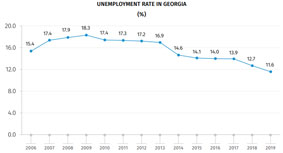
Decreasing unemployment trend maintained in 2019
By Natalia Kochiashvili
Tuesday, May 19
On 18th of May, the National statistics office of Georgia (Geostat) released a report on indicators of economic activity of the population in 2019, concerning the employment issues. As reported, in 2019, a record low unemployment rate was recorded in Georgia - 11.6%. For comparison, in 2018 the corresponding number was 12.7%, and in 2017 - 13.9%.
According to Geostat, the reduction in unemployment was influenced by the reduction of the economically active population in the country. As of 2019, the share of economically active population in relation to the total population was 62.9%, in 2018 this figure was 63.9%.
“In comparison to the previous year, the economic activity rate decreased by 1%, while the employment rate also decreased by 0.2 %,” read the report.
This means that the main factor in reducing unemployment was not the increase in the absolute number of employees, but the decrease in the volume of the population in relation to which the number of unemployed is calculated. In total, the economically active population decreased by 28,700 people last year to 1,911,200.
However, despite this reduction, the highest unemployment still remains in the youth group and it is 30.5% in the 20-24 age category, while this indicator is traditionally the lowest in the 65+ age group (2.4%) that is mainly caused by the high rate of inactivity in this age group. This means that one third of young people are unemployed. Unemployment in the 25-29 age group is 18.5%.
In 2019, compared to the previous year, the unemployment was decreased by 1.1% for women as well as for men and amounted to 10.1 and 12.8%, respectively. Geostat said that traditionally, the unemployment rate is higher in men than in women.
In 2019, the employment rate for women decreased by 0.3% compared to 2018, while for men by 0.1%.
Geostat says, in 2019, instead of an increase in the total number of employees in the country, their decrease was observed. A total of 1,690,200 people were employed last year. In 2018, the total number of employees was 4,000 more.
Statistics office also reports that the ratio between self-employed and hired workers has changed slightly. In particular, the number of employees was reduced by 0.5%. In 2019, the total number of employees was 50.3%, while the number of self-employed was 49.7%. It should be noted that the number of hired employees has exceeded the number of self-employed persons for the last 2 years. Most of the self-employed in Georgia are employed in agriculture.
Unemployment in rural areas is 5.5%, and in urban areas it is 4 times higher, at 17.4%, and this is due to the fact that rural residents who worked in agriculture for wages or other benefits (food wages, etc.) are considered employed.
In urban settlements the employment rate increased by 0.2% compared to 2018, while in rural settlements it decreased by 0.7%. Compared to 2018 the unemployment rate decreased both in urban and rural settlements by 1.8 and 0.3%, respectively.
The unemployment rate increased only in Guria (0.8%) and Kakheti (0.1%) regions of Georgia. In the capital city of Tbilisi, where the unemployment rate is the highest, this indicator was decreased by 1.1%.
The largest decrease was observed in Shida Kartli (3 %) and Samegrelo-Zemo Svaneti (2.1%) regions.
The Geostat methodology considers an employee a person 15 years of age and older, who during the reporting period performs certain work for the purpose of receiving a salary or other remuneration (in cash or in kind). Also a person who has a job but does not work temporarily for various reasons.
A self-employed person is an owner who works for profit or to support a family (with money or nature). Also, a person who works in a family enterprise without any compensation (free of charge).
Unemployed are 15-year-old and senior citizens who have not completed a single hour of work for 7 days prior to the survey to receive compensation or other benefits.


